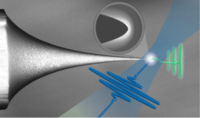当前位置:
X-MOL 学术
›
Rev. Mod. Phys.
›
论文详情
Our official English website, www.x-mol.net, welcomes your feedback! (Note: you will need to create a separate account there.)
Strong-field nano-optics
Reviews of Modern Physics ( IF 44.1 ) Pub Date : 2020-06-09 , DOI: 10.1103/revmodphys.92.025003 Péter Dombi , Zsuzsanna Pápa , Jan Vogelsang , Sergey V. Yalunin , Murat Sivis , Georg Herink , Sascha Schäfer , Petra Groß , Claus Ropers , Christoph Lienau
Reviews of Modern Physics ( IF 44.1 ) Pub Date : 2020-06-09 , DOI: 10.1103/revmodphys.92.025003 Péter Dombi , Zsuzsanna Pápa , Jan Vogelsang , Sergey V. Yalunin , Murat Sivis , Georg Herink , Sascha Schäfer , Petra Groß , Claus Ropers , Christoph Lienau

|
The present status and development of strong-field nano-optics, an emerging field of nonlinear optics, is discussed. A nonperturbative regime of light-matter interactions is reached when the amplitude of the external electromagnetic fields that are driving a material approach or exceed the field strengths that bind the electrons inside the medium. In this strong-field regime, light-matter interactions depend on the amplitude and phase of the field, rather than its intensity, as in more conventional perturbative nonlinear optics. Traditionally such strong-field interactions have been intensely investigated in atomic and molecular systems, and this has resulted in the generation of high-harmonic radiation and laid the foundations for contemporary attosecond science. Over the past decade, however, a new field of research has emerged, the study of strong-field interactions in solid-state nanostructures. By using nanostructures, specifically those made out of metals, external electromagnetic fields can be localized on length scales of just a few nanometers, resulting in signficantly enhanced field amplitudes that can exceed those of the external field by orders of magnitude in the vicinity of the nanostructures. This leads not only to dramatic enhancements of perturbative nonlinear optical effects but also to significantly increased photoelectron yields. It resulted in a wealth of new phenomena in laser-solid interactions that have been discovered in recent years. These include the observation of above-threshold photoemission from single nanostructures, effects of the carrier-envelope phase on the photoelectron emission yield from metallic nanostructures, and strong-field acceleration of electrons in optical near fields on subcycle timescales. The current state of the art of this field is reviewed, and several scientific applications that have already emerged from the fundamental discoveries are discussed. These include, among others, the coherent control of localized electromagnetic fields at the surface of solid-state nanostructures and of free-electron wave packets by such optical near fields, resulting in the creation of attosecond electron bunches, the coherent control of photocurrents on nanometer length and femtosecond timescales by the electric field of a laser pulse, and the development of new types of ultrafast electron microscopes with unprecedented spatial, temporal, and energy resolution. The review concludes by highlighting possible future developments, discussing emerging topics in photoemission and potential strong-field nanophotonic devices, and giving perspectives for coherent ultrafast microscopy techniques. More generally, it is shown that the synergy between ultrafast science, plasmonics, and strong-field physics holds promise for pioneering scientific discoveries in the upcoming years.
中文翻译:

强场纳米光学
讨论了非线性光学的新兴领域-强场纳米光学的现状和发展。当驱动材料的外部电磁场的振幅接近或超过将介质中的电子束缚在一起的场强时,便达到了光-物质相互作用的非扰动状态。在这种强场状态下,光-质相互作用取决于场的幅度和相位,而不是像更常规的摄动非线性光学器件那样取决于场的强度。传统上,已经在原子和分子系统中对这种强场相互作用进行了深入研究,这导致了高谐波辐射的产生,并为当代阿秒科学奠定了基础。但是在过去的十年中,出现了一个新的研究领域,固态纳米结构中强场相互作用的研究。通过使用纳米结构,特别是由金属制成的纳米结构,外部电磁场可以定位在仅几纳米的长度尺度上,从而导致纳米结构附近的场振幅显着增强,可以比外部场的振幅大几个数量级。 。这不仅导致扰动非线性光学效应的显着增强,而且导致光电子产率的显着提高。这导致了近年来发现的大量的激光-固体相互作用新现象。这些包括观察单个纳米结构的阈值以上的光发射,载流子-包封相对金属纳米结构的光电子发射率的影响,在子周期时标上电子在光学近场中的强场加速。回顾了该领域的当前技术水平,并讨论了从基础发现中已经出现的几种科学应用。其中包括:通过此类光学近场对固态纳米结构表面的局部电磁场和自由电子波包进行相干控制,从而产生阿秒电子束;对纳米级的光电流进行相干控制。长度和飞秒的时间尺度受激光脉冲电场的影响,以及新型超快电子显微镜的发展,其具有空前的空间,时间和能量分辨率。审查总结了可能的未来发展,讨论了光发射和潜在的强场纳米光子器件中的新兴主题,并为相干超快速显微镜技术提供了前景。更普遍地,它表明超快科学,等离激元学和强场物理学之间的协同作用有望在未来几年中开拓科学发现。
更新日期:2020-06-09
中文翻译:

强场纳米光学
讨论了非线性光学的新兴领域-强场纳米光学的现状和发展。当驱动材料的外部电磁场的振幅接近或超过将介质中的电子束缚在一起的场强时,便达到了光-物质相互作用的非扰动状态。在这种强场状态下,光-质相互作用取决于场的幅度和相位,而不是像更常规的摄动非线性光学器件那样取决于场的强度。传统上,已经在原子和分子系统中对这种强场相互作用进行了深入研究,这导致了高谐波辐射的产生,并为当代阿秒科学奠定了基础。但是在过去的十年中,出现了一个新的研究领域,固态纳米结构中强场相互作用的研究。通过使用纳米结构,特别是由金属制成的纳米结构,外部电磁场可以定位在仅几纳米的长度尺度上,从而导致纳米结构附近的场振幅显着增强,可以比外部场的振幅大几个数量级。 。这不仅导致扰动非线性光学效应的显着增强,而且导致光电子产率的显着提高。这导致了近年来发现的大量的激光-固体相互作用新现象。这些包括观察单个纳米结构的阈值以上的光发射,载流子-包封相对金属纳米结构的光电子发射率的影响,在子周期时标上电子在光学近场中的强场加速。回顾了该领域的当前技术水平,并讨论了从基础发现中已经出现的几种科学应用。其中包括:通过此类光学近场对固态纳米结构表面的局部电磁场和自由电子波包进行相干控制,从而产生阿秒电子束;对纳米级的光电流进行相干控制。长度和飞秒的时间尺度受激光脉冲电场的影响,以及新型超快电子显微镜的发展,其具有空前的空间,时间和能量分辨率。审查总结了可能的未来发展,讨论了光发射和潜在的强场纳米光子器件中的新兴主题,并为相干超快速显微镜技术提供了前景。更普遍地,它表明超快科学,等离激元学和强场物理学之间的协同作用有望在未来几年中开拓科学发现。


























 京公网安备 11010802027423号
京公网安备 11010802027423号